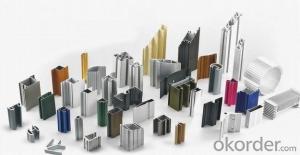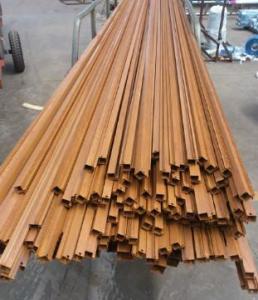Aluminum Alloy Profiles Walkway
OKorder Service Pledge
OKorder Financial Service
You Might Also Like
We are the largest aluminum profilemanufacture in
The detail descriptions of aluminum profile as bellowing:
Alloy Aluminum 6063,6061,6005,6082 or customer nominated | |
Temper | T3, T4, T5, T6 and other |
Surface | Anodize, electrophoresis, powder coating, PVDF coating, etc. |
Colour | Any colour based on Standard Germany RAL Mark |
Length | Not more than 16 meters |
Good Package | Inner plastic film /outside carton/wooden pallets |
Payment Method | T/T, L/C, etc |
Delivery Time | Normally 2-4 weeks, Delivery time can be consulted. |
Press Machine | 500-12500 tons all together 93 press lines. |
Fabrication | 1. Windows and doors; 2. Drilling; 3. Bending; 4. Cutting; 5. etc. |
Certificate | ISO/TS 16949,DNV,IRIS,CCS,AFA,etc. |
Dies | 1. Using our dies, no fee; |
2. Using customer drawing, opening dies, usually about 5~50 tons then the dies cost can be refunded. | |
3. Die cost is negotiable base on the order quantity | |
Capability | Annual output 800,000 tons |
- Q: This question asks for methods to prevent moisture from entering aluminum profiles during the installation process.
- <p>To prevent moisture from getting into aluminum profiles during installation, ensure proper sealing and insulation. Use high-quality weatherstripping and sealants around joints and connections. Install moisture barriers or vapor retarders where necessary, especially in areas prone to high humidity. Keep profiles dry during handling and storage, and avoid installing in wet conditions. Regularly inspect and maintain the profiles to identify and address any potential moisture issues early.</p>
- Q: Are aluminum profiles suitable for food processing applications?
- Yes, aluminum profiles are suitable for food processing applications. Aluminum is a lightweight and corrosion-resistant material that is widely used in the food processing industry due to its many benefits. Firstly, aluminum profiles are easy to clean and maintain, which is essential in food processing environments where hygiene is of utmost importance. They can be easily washed and sterilized to prevent any cross-contamination or bacterial growth. Secondly, aluminum is non-toxic and does not react with food or beverages, ensuring that the integrity and quality of the processed products are not compromised. This is particularly important for acidic or alkaline foods that may react with other materials. Furthermore, aluminum profiles have excellent thermal conductivity, allowing for efficient heat transfer during processing, such as in baking or cooling operations. This helps to ensure uniform heat distribution and consistent results. Additionally, aluminum is a sustainable material that can be recycled repeatedly without losing its properties. This aligns with the increasing focus on sustainability and environmental responsibility in the food processing industry. Overall, the characteristics of aluminum profiles make them a suitable choice for food processing applications, providing durability, cleanliness, and compatibility with food products.
- Q: Are aluminum profiles suitable for use in exterior wall insulation systems for residential buildings?
- <p>Yes, aluminum profiles can be used for exterior wall insulation systems in residential buildings. They are known for their durability, corrosion resistance, and low thermal conductivity, which makes them ideal for creating thermal barriers. Aluminum profiles can support the structure of the insulation system, providing a stable framework while also contributing to energy efficiency by reducing heat transfer. However, it's important to ensure that the profiles are properly sealed and insulated to prevent thermal bridging and to maintain the overall insulation performance of the building envelope.</p>
- Q: This question asks about the various types of aluminum profiles that are utilized specifically for constructing wall frames.
- <p>Aluminum profiles for wall frames come in various types, each serving specific purposes. Common types include: 1) Structural profiles, which provide the main support and strength to the frame; 2) Cover profiles, used to conceal joints and fasteners, enhancing the aesthetic appeal; 3) Insulation profiles, designed to provide thermal insulation; 4) Glazing profiles, used to hold glass or other transparent materials in place; 5) Corner profiles, for joining two walls at a right angle; 6) Sealing profiles, to ensure weatherproofing and airtightness; and 7) Special profiles, tailored for unique architectural designs or specific functions. Each type is chosen based on the structural requirements, design aesthetics, and performance needs of the wall system.</p>
- Q: Can aluminum profiles be used for skylights?
- Skylights can indeed utilize aluminum profiles. The durability, strength, and corrosion resistance of aluminum make it a popular choice for skylight frames. Its lightweight yet robust nature ensures the skylight glass is adequately supported and guarantees long-lasting performance. Furthermore, aluminum profiles can be effortlessly tailored and molded to meet specific design needs, enabling a wide range of skylight styles and sizes. Incorporating aluminum profiles in skylights also offers exceptional thermal insulation, promoting energy efficiency by minimizing heat transfer and condensation. In summary, aluminum profiles are a dependable and pragmatic choice for skylight construction.
- Q: What are the different accessories available for aluminum profiles?
- There are various accessories available for aluminum profiles, such as corner connectors, end caps, T-slot nuts, brackets, hinges, handles, leveling feet, and panel fasteners. These accessories help enhance the functionality and versatility of aluminum profiles in different applications, such as constructing frames, enclosures, and machinery.
- Q: How do aluminum profiles perform in wind-resistant structures?
- Aluminum profiles are known for their excellent performance in wind-resistant structures. Due to their inherent strength and durability, they are able to withstand high wind pressures and maintain structural integrity. The lightweight nature of aluminum makes it an ideal material for constructing wind-resistant structures as it reduces the overall load on the building without compromising its strength. Aluminum profiles have high tensile strength and are resistant to corrosion, making them suitable for withstanding harsh weather conditions, including strong winds. They also have a high stiffness-to-weight ratio, meaning they can effectively distribute the wind load and minimize deflection. This characteristic is essential in wind-resistant structures as it helps to prevent excessive movement and ensures the safety of the building and its occupants. Furthermore, aluminum profiles can be easily fabricated and customized, allowing for the creation of complex and innovative designs. This flexibility in design enables architects and engineers to optimize the aerodynamics of the structure, further enhancing its resistance to wind forces. Additionally, aluminum profiles can be combined with other materials, such as glass or composite panels, to create a more robust and efficient wind-resistant system. Overall, aluminum profiles are highly reliable and efficient in wind-resistant structures. Their strength, lightweight nature, corrosion resistance, and flexibility in design make them an excellent choice for constructing buildings that can withstand strong winds and ensure the safety and longevity of the structure.
- Q: Are aluminum profiles suitable for playground equipment?
- Playground equipment can be made from aluminum profiles, which are lightweight and durable materials commonly used in many industries, including playground equipment manufacturing. These profiles are known for their strength and resistance to corrosion, making them perfect for outdoor use. They provide stability and can handle the weight and forces exerted during play. In addition, aluminum is non-toxic and does not rust, ensuring the safety and longevity of the equipment. The versatility of aluminum allows for the creation of various shapes and designs, offering endless possibilities for innovative and attractive playground structures. In summary, aluminum profiles are an ideal choice for playground equipment due to their strength, durability, and safety features.
- Q: How do aluminum profiles perform in electrical insulation applications?
- When it comes to electrical insulation applications, aluminum profiles typically do not excel. Unlike plastic or rubber materials, aluminum conducts electricity and lacks the necessary insulating properties to hinder the flow of electric current. Consequently, employing aluminum profiles for electrical insulation applications entails substantial hazards, including the potential for electric shock or short circuits. It is crucial to opt for materials explicitly engineered for electrical insulation purposes, such as insulating plastics or rubber, to guarantee the safety and efficacy of electrical systems.
- Q: Measuring 3 meters long aluminum profiles of the straightness, you have what good method? What is the maximum deviation value allowed by our industry? In addition to the platform measurement, and what are the economic and practical methods, our factory stalls are small. Consider input costs.
- For bending, twist test should be adopted according to the requirements of the platform, but in actual use, the platform used as a simple test tube can also be used to forming good Aluminum Alloy square or rectangular, note the tube before use, the first to confirm the test, can be used as a test platform.
Send your message to us
Aluminum Alloy Profiles Walkway
OKorder Service Pledge
OKorder Financial Service
Similar products
Hot products
Hot Searches
Related keywords
























